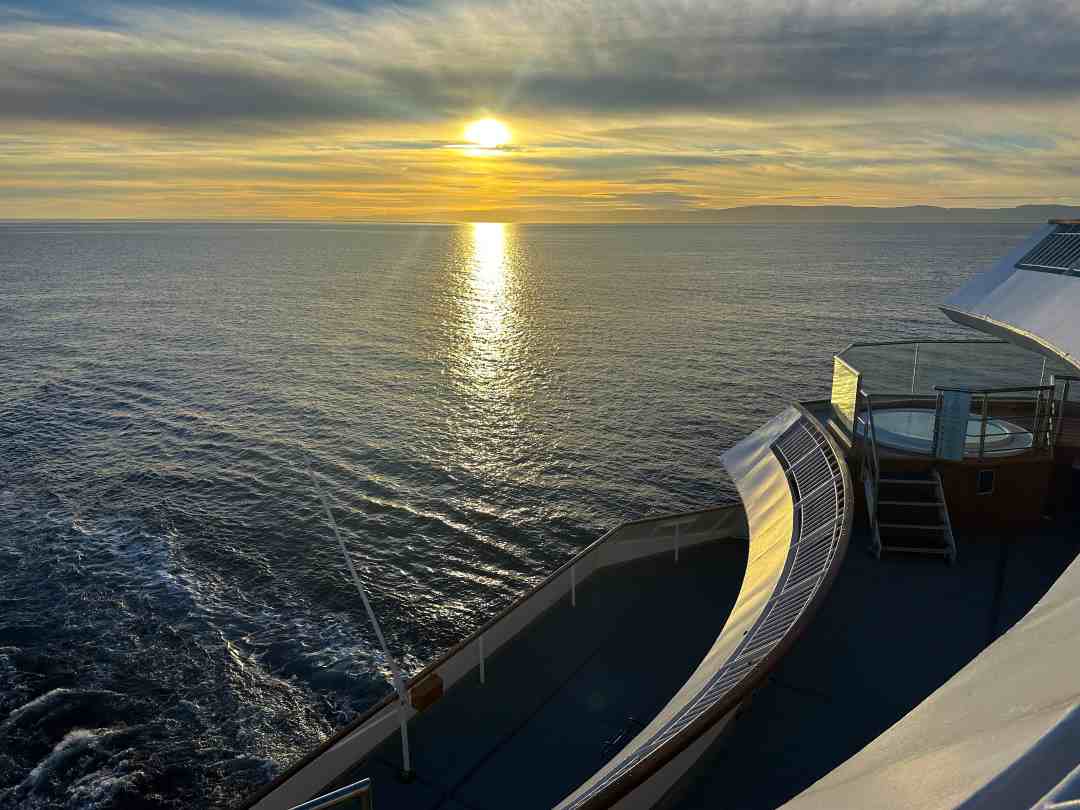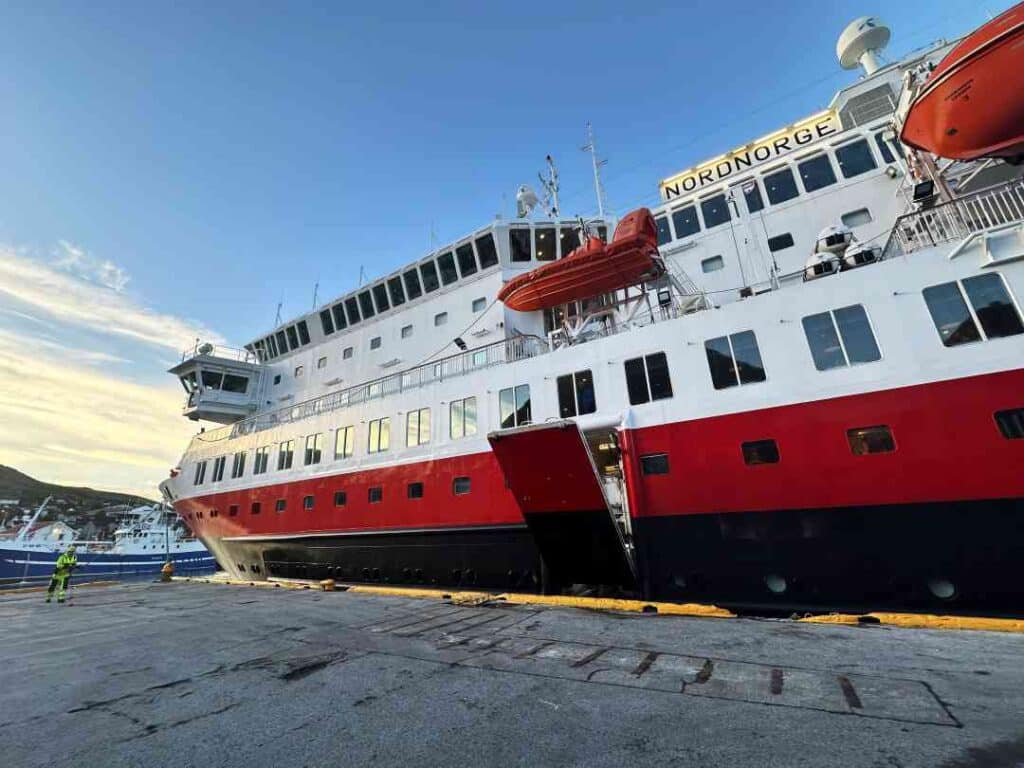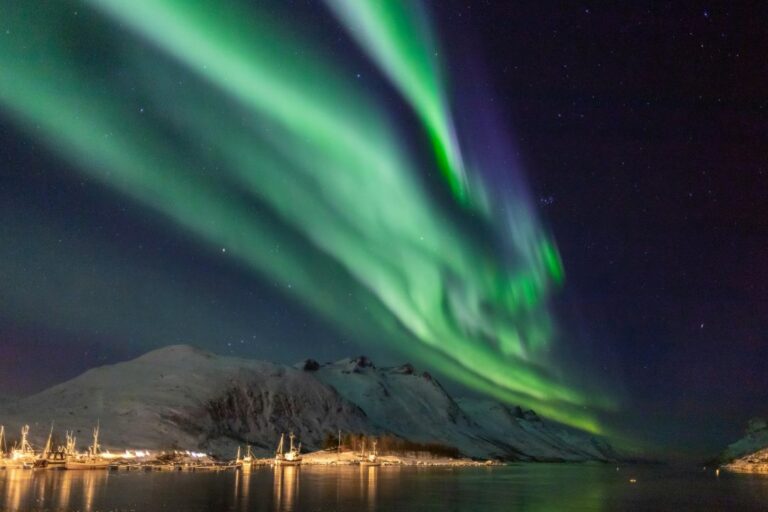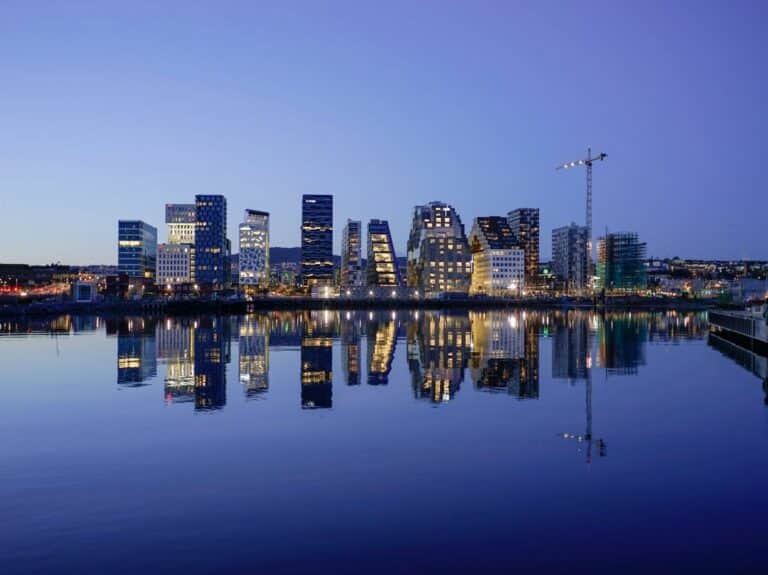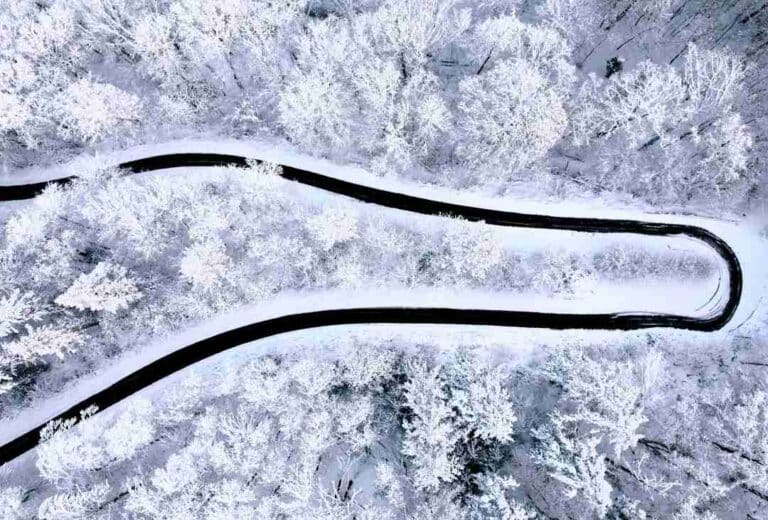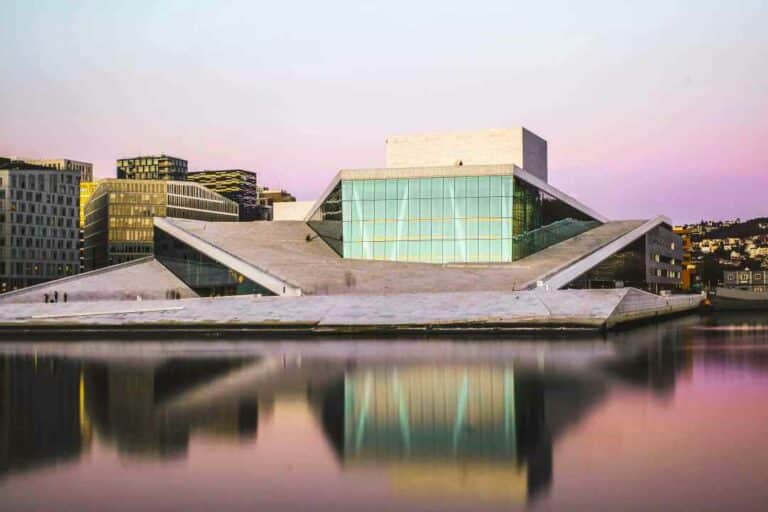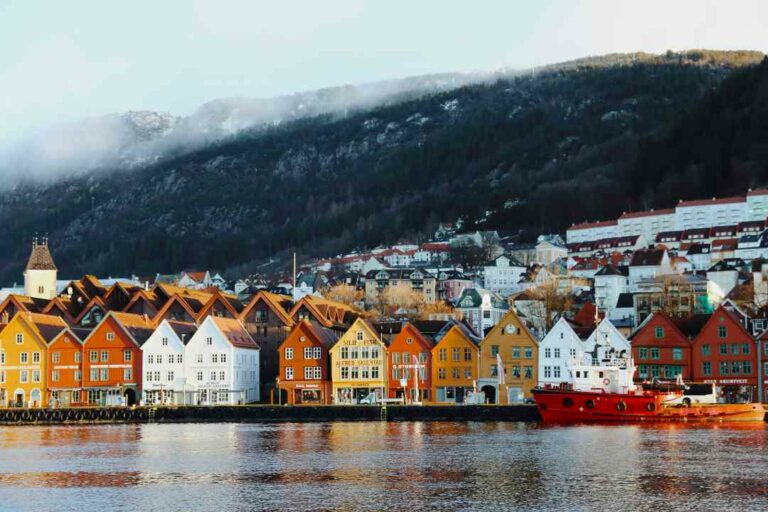Hurtigruten Norwegian Coastal Voyage: The Ultimate Guide to Norway’s Stunning Coastline
As a Norwegian native and avid solo female traveler, I’ve had the privilege of experiencing the breathtaking beauty of my home country in countless ways for years, including the famous Norwegian coastal voyage.
Doing road trips, epic train rides, iconic mountain hikes, wilderness camping, backcountry skiing, and luxury stays, there are countless ways to explore the beauty of Norway.
But nothing quite compares to the awe-inspiring journey along Norway’s rugged coastline aboard a Hurtigruten ship that I just did!
The Hurtigruten coastal voyage is often called the “world’s most beautiful sea voyage,” and I can tell you firsthand that it is with good reason.
This article contains affiliate links! If you like this free content and use my links to make your bookings, I get a small commission at no extra cost to you. Thank You!
The Iconic Hurtigruten Coastal Voyage
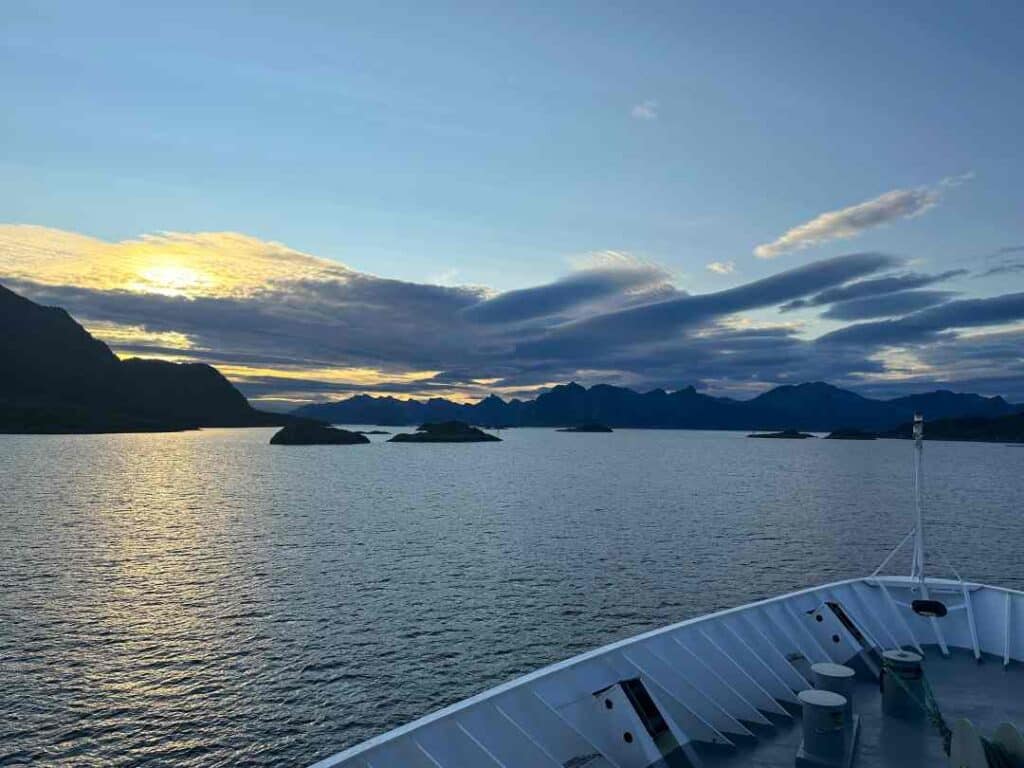
In a land where fjords carve deep into snow-capped mountains, where the midnight sun bathes the landscape in golden light during summer, and where the ethereal northern lights dance across winter skies, you can experience it all from just outside the rugged coastline.
Including all the fjords and islands, Norway’s coastline is a staggering 89,000 kilometers long, dotted with 1,700 fjords and over 230,000 islands that tell a story of nature’s raw power and beauty.
And there’s no better storyteller than Hurtigruten.
Hurtigruten, which translates to “the fast route” in Norwegian, has been an integral part of coastal life in Norway for over 125 years. Every day, one northbound and one southbound ship stops in each of the 34 ports along the coast.
So if you miss a ship departure, you have to wait 24 hours for the next one!
What began in 1893 as a crucial maritime link for isolated coastal communities has evolved into an iconic travel experience that combines the charm of a working ship with the comfort of a modern explorer vessel.
This iconic journey allows you to witness the ever-changing landscape of Norway’s coastline year round, from the cultural hub of Bergen in the south to the Arctic wilderness of Kirkenes in the far northeast (and back again if you want to).
In my opinion, the Hurtigruten voyage offers an unparalleled opportunity to capture the essence of Norway’s coastal beauty and culture.
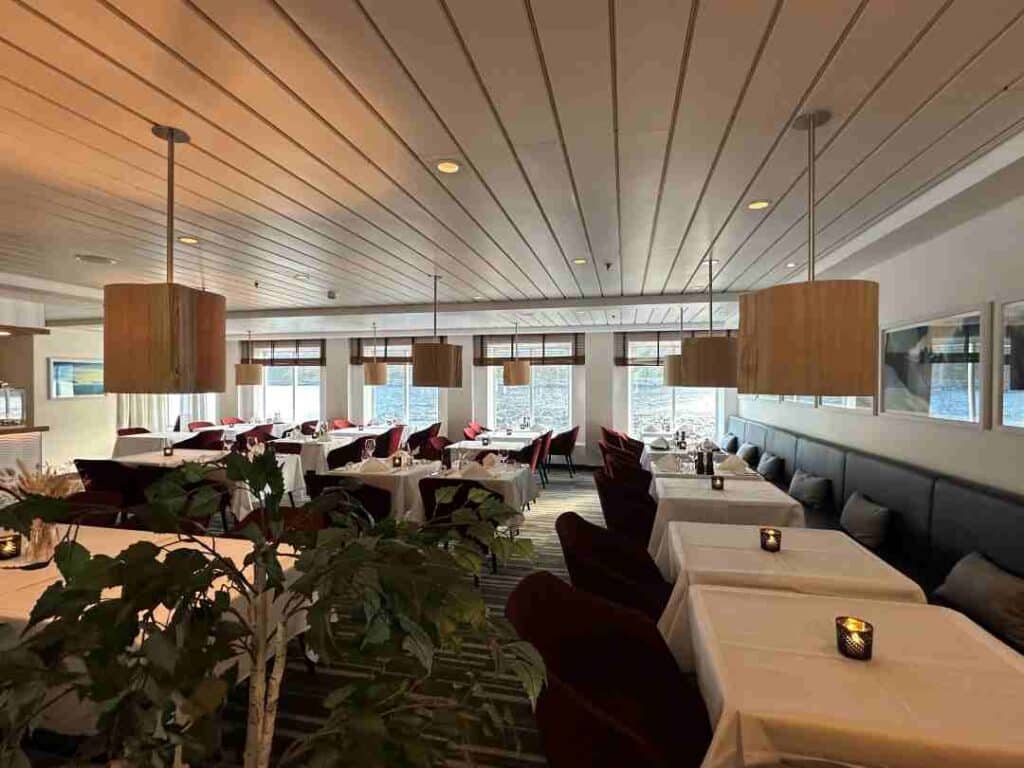
From the deck of one of their nine ships, you’re not just observing Norway – you’re living it, breathing it, and becoming a part of its slower coastal rhythm.
📍 EpicNomadLife Tip: Check prices and availability for Hurtigruten in this link. Remember that you can choose a port-to-port journey, you don’t have to do the entire coastline in one go!
The Hurtigruten Experience: A Journey Like No Other
The full Hurtigruten voyage is a 13-day round trip from Bergen to Bergen that covers 2,500 nautical miles, stopping at 34 ports along the way.
This journey takes you into several fjords, between islands, past the Arctic Circle, around the North Cape (the northernmost point of mainland Europe), and all the way to Kirkenes.
What sets Hurtigruten apart from traditional cruises is its dual role as both a passenger ship and a cargo vessel.
This unique aspect means you’ll witness Norway’s authentic coastal life, watching locals use the ship for transportation and goods loaded and unloaded at various ports.
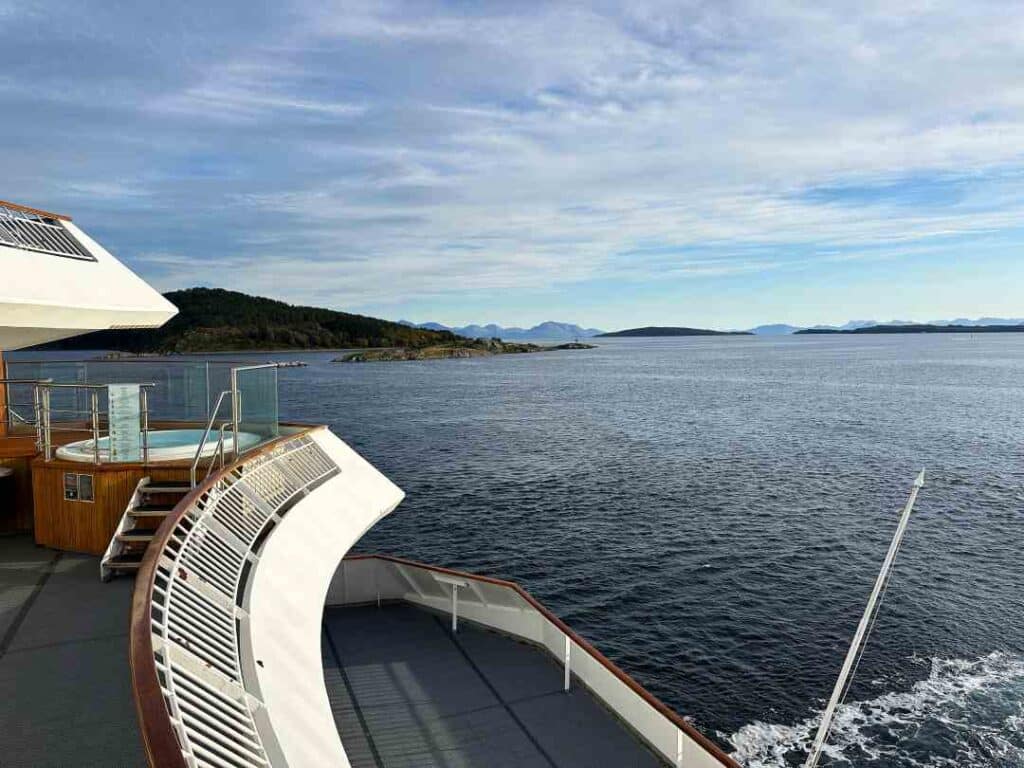
It’s a living, breathing part of Norwegian culture and history.
I had my first Hurtigruten journey years ago, and there is something really special about this particular “cruise” along the Norwegian coast.
Back in the day, before decent roads and airports, the arrival of the Hurtigruten ship was a lifeline for the locals in small communities. It brought supplies and mail and connected them to the rest of the country.
The ships themselves are still a perfect blend of comfort and functionality today, as you will discover.
Amenities On Board
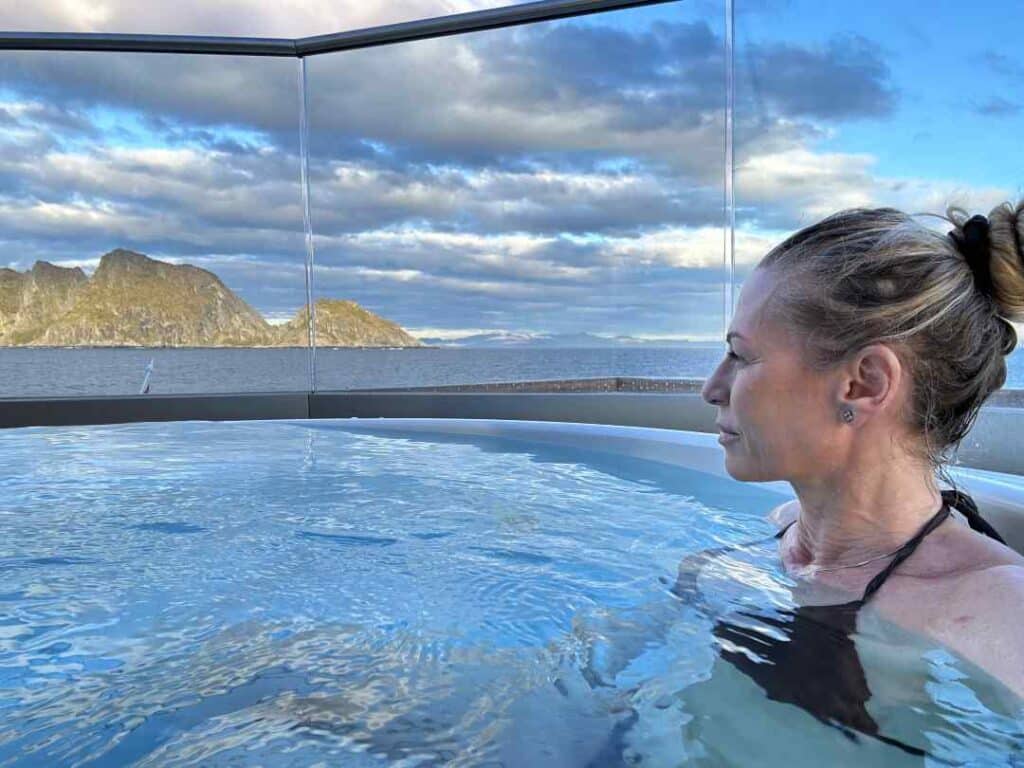
While Hurtigruten offers amenities like restaurants and lounges, hot tubs, and fitness rooms, they’re designed to navigate the Norwegian coast’s narrow fjords and small harbors.
With the rather small ships taking just over 600 passengers, this intimate setting allows for a more personal and immersive travel experience.
Hurtigruten’s commitment to sustainability is also noteworthy.
The company is a pioneer in green shipping, with initiatives including hybrid-powered ships, a ban on single-use plastics, and locally sourced food.
As an eco-conscious traveler, I appreciate their efforts to preserve the pristine environments we sail through.
Hurtigruten Ports: A Journey Through Norway’s Coastal Wonders
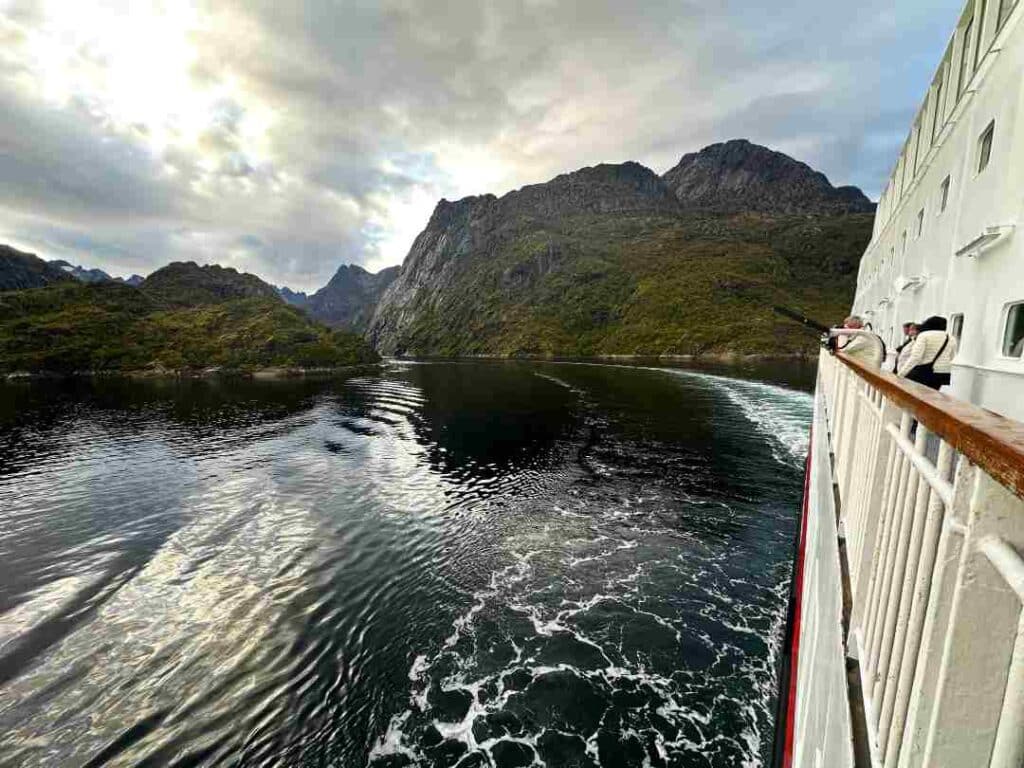
The Hurtigruten route includes 34 ports, each with its own unique charm and attractions.
Here’s a more detailed look at some key stops (you’ll find the complete list of Hurtigruten ports at the end of the article).
Bergen
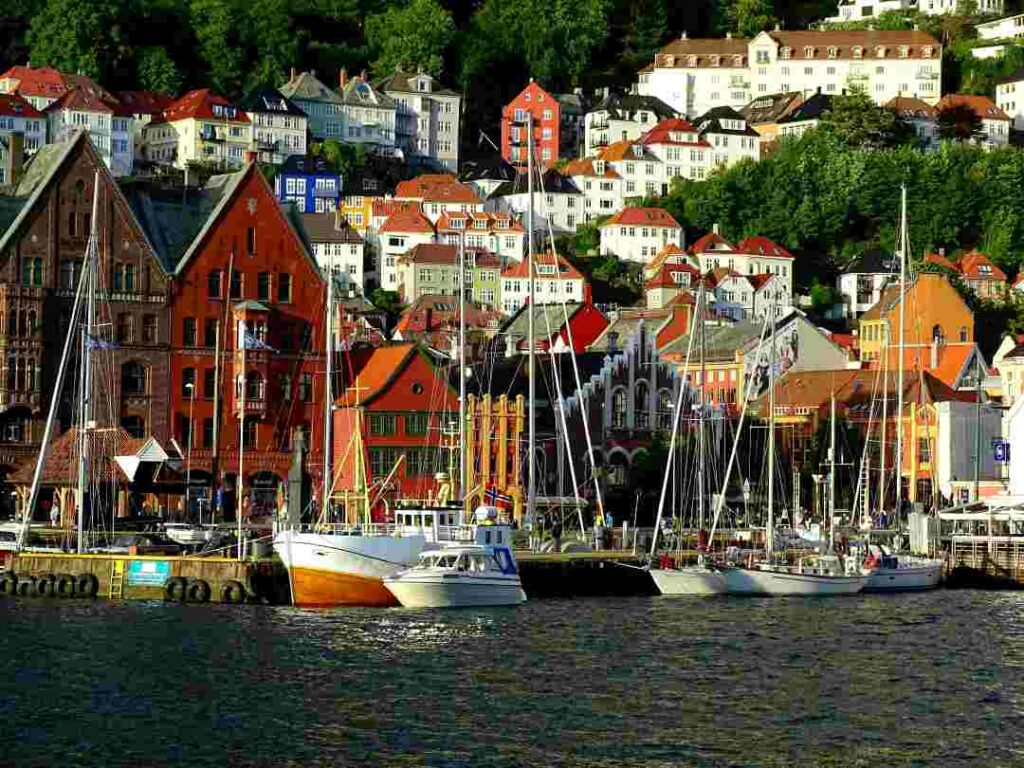
Known as the “Gateway to the Fjords,” Bergen is the southern starting point for the Hurtigruten voyage. It is also a UNESCO World Heritage city famous for its colorful Hanseatic wharf, Bryggen.
If you start your journey here, make sure you stay a couple of days in Bergen before your departure; there are a lot of things to see and do here!
You don’t want to miss iconic experiences like the Bergen Brygge fish market, a ride on the Fløibanen funicular for panoramic views, or a stroll through the narrow alleyways of the old town.
Also read: Best Things To Do In Bergen Norway From A Native
Ålesund
Rebuilt in Art Nouveau style after a devastating fire in 1904, Ålesund is a photographer’s dream.
Climb the 418 steps to the viewpoint of Mount Aksla for breathtaking views of the archipelago. The Atlantic Sea Park, one of Northern Europe’s largest saltwater aquariums, is also worth a visit.
Trondheim
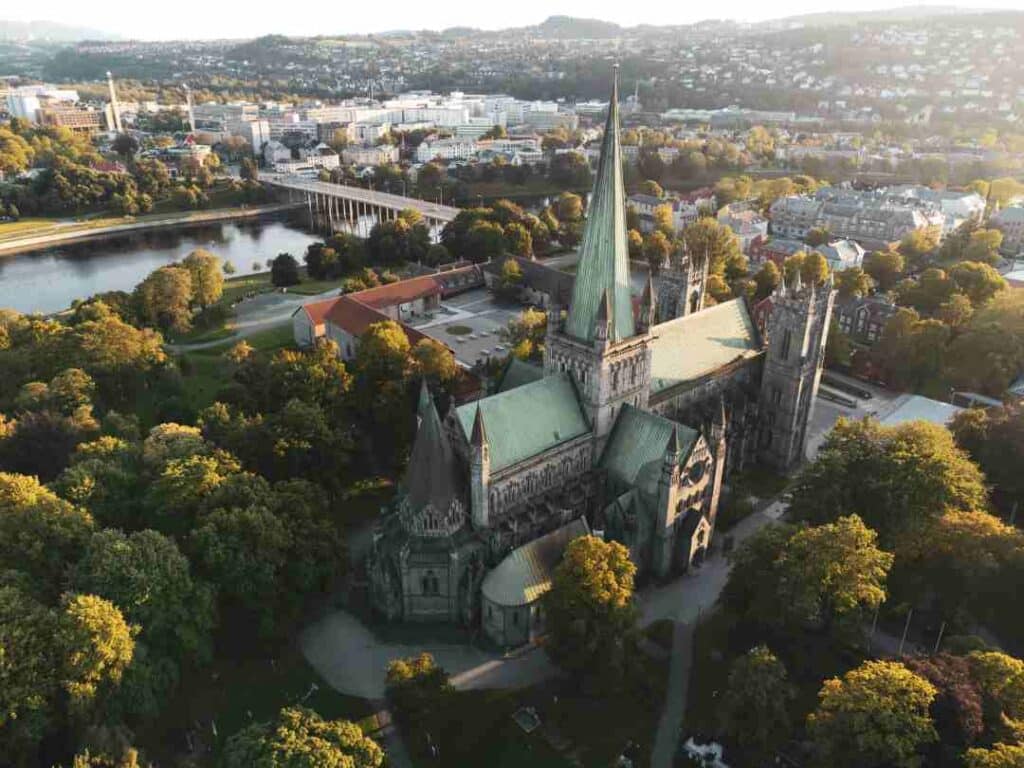
Norway’s third-largest city and former capital, Trondheim, boasts the impressive Nidaros Cathedral and charming wooden architecture (the town’s medieval name was Nidaros).
Explore the trendy Bakklandet neighborhood with its colorful wooden houses, or visit the Ringve Museum, Norway’s national museum of music and musical instruments.
Also read: Best Things To Do In Trondheim – A Natives Guide
Bodø
“The windy city” north of the Arctic Circle, Bodø offers opportunities to see the midnight sun in summer and the northern lights in winter. Bodø is situated just across from the iconic Lofoten Islands, where Svolvær is also a Hurtigruten port.
The Saltstraumen maelstrom, the world’s strongest tidal current, is a must-see natural wonder located just outside the city.
Tromsø
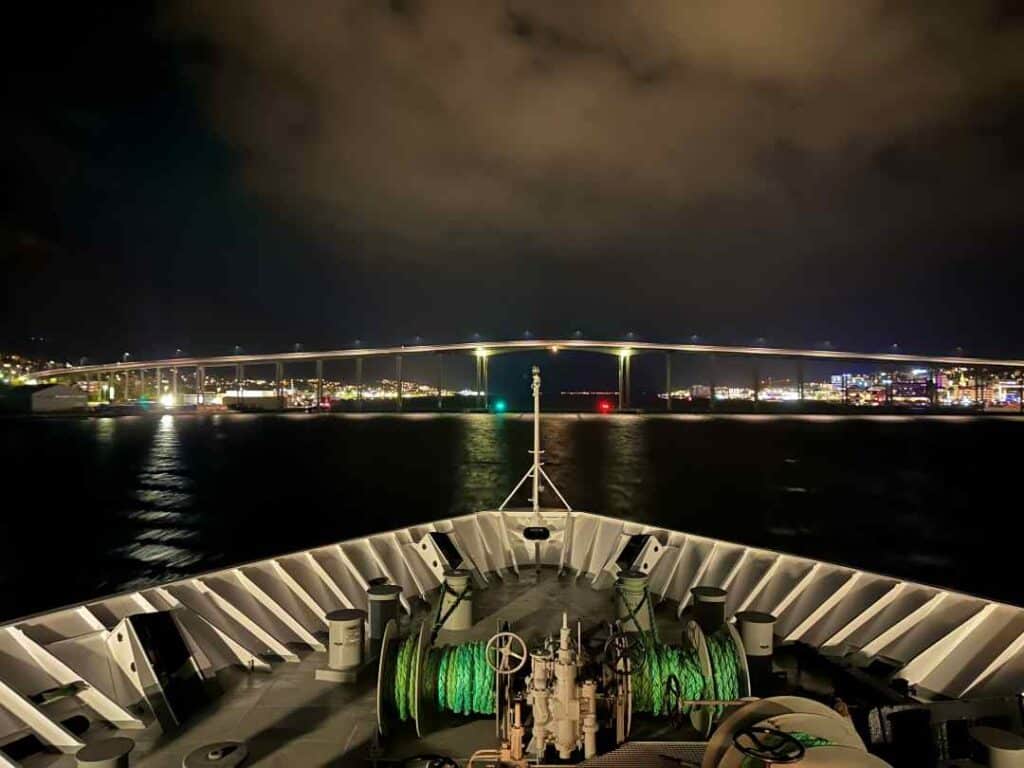
Often called the “Paris of the North,” Tromsø is a vibrant Arctic city known for its rich culture and scientific research.
The southbound Hurtigruten arrives here just before midnight, and you can join a midnight concert in the old wooden town church.
You can also visit the Arctic Cathedral, Ishavskatedralen, take a cable car ride for stunning views, or immerse yourself in Sami culture at the Tromsø Museum.
Honningsvåg
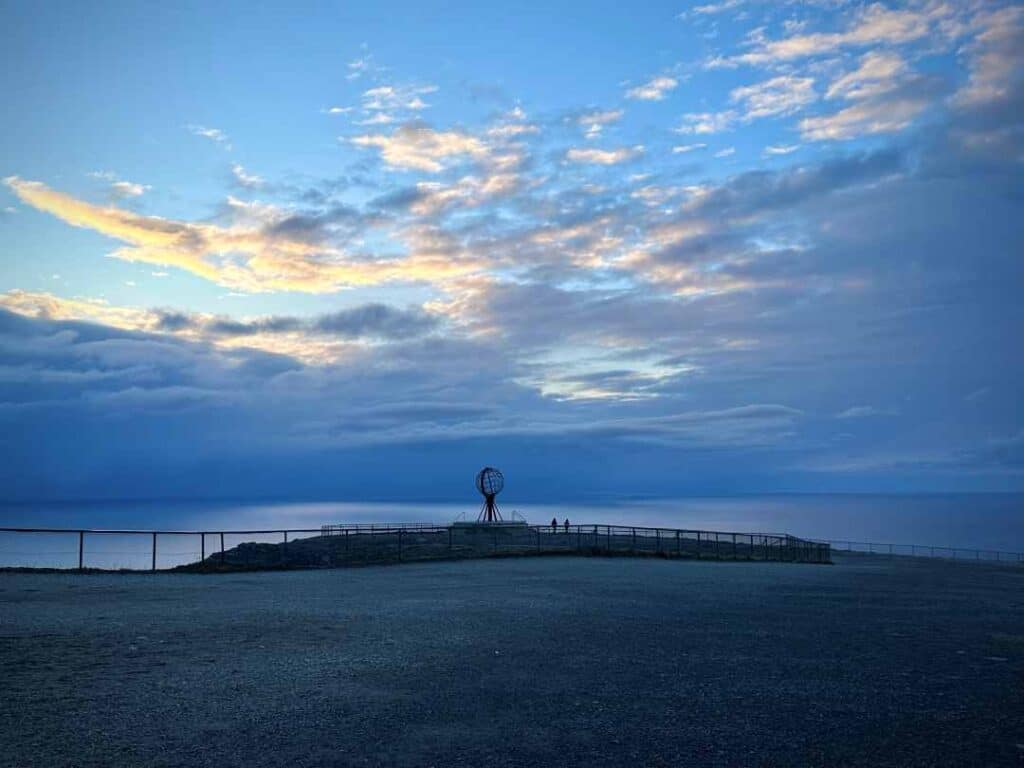
The northernmost city on the mainland of Norway, Honningsvåg, is the gateway to the North Cape plateau. Standing atop the 307-meter-high cliff overlooking the Arctic Ocean is a bucket-list experience for many travelers.
The North Cape is situated about 35 kilometers north of Honningsvåg, so remember that when you dock here, you still need to get yourself the last distance!
You can rent a car in Honningsvåg or book an organized tour at the tourist information situated two minutes from the port where you arrive.
You can also book the the tour online before you get there, and other adventure tours like RIB safari below the plateau, ATV trips, and bird-watching boat tours.
Kirkenes
The turnaround point of the Hurtigruten voyage, Kirkenes, is located just 15 km from the Russian border. Situated on a peninsula along the Bøkefjorden Fjord, Kirkenes is home to around 3400 people.
You will see that all road signs are in two languages, sometimes even three: Norwegian, Sami, and Russian. The polar night lasts exactly two months in Kirkenes, and in the wild nature, you find the largest brown bear population lives in this area.
In winter, you can stay at the Snow Hotel here or go king crab fishing on the frozen fjords.
See the full list of Hurtigruten ports at the end of the article.
Life Onboard Hurtigruten Ships: More Than Just a Cruise
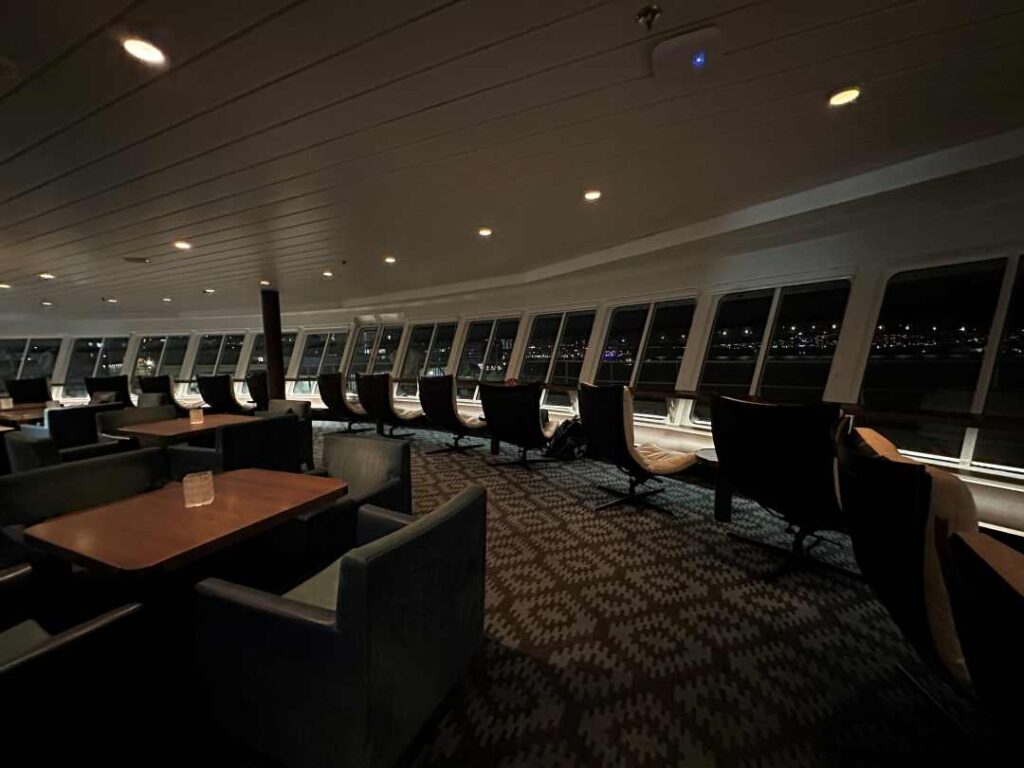
Life onboard a Hurtigruten ship is a blend of relaxation, education, and adventure. The ships offer comfortable cabins, ranging from cozy interior rooms to spacious suites with panoramic views.
One of the highlights of the journey is the locally sourced cuisine. Hurtigruten’s “Norway’s Coastal Kitchen” concept means you’ll enjoy fresh, seasonal ingredients from local suppliers along the route.
I’ve savored everything from freshly caught Arctic char to hand-picked cloudberries, each dish telling a story of Norway’s diverse culinary landscape.
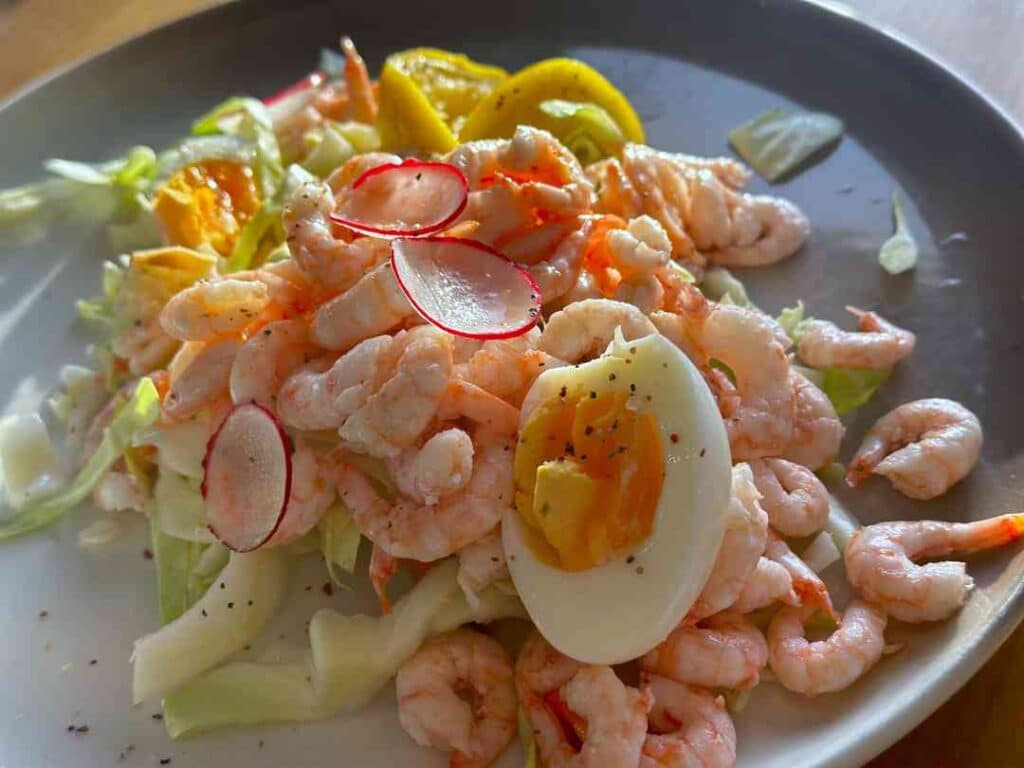
Educational experiences are also a key part of the Hurtigruten experience.
The onboard Expedition Team offers lectures and presentations on various topics related to Norwegian nature, culture, and history.
You might learn about the northern lights, Viking history, or the unique ecosystem of the Norwegian coast.
These sessions have deepened my understanding and appreciation of my own country in ways I never expected.
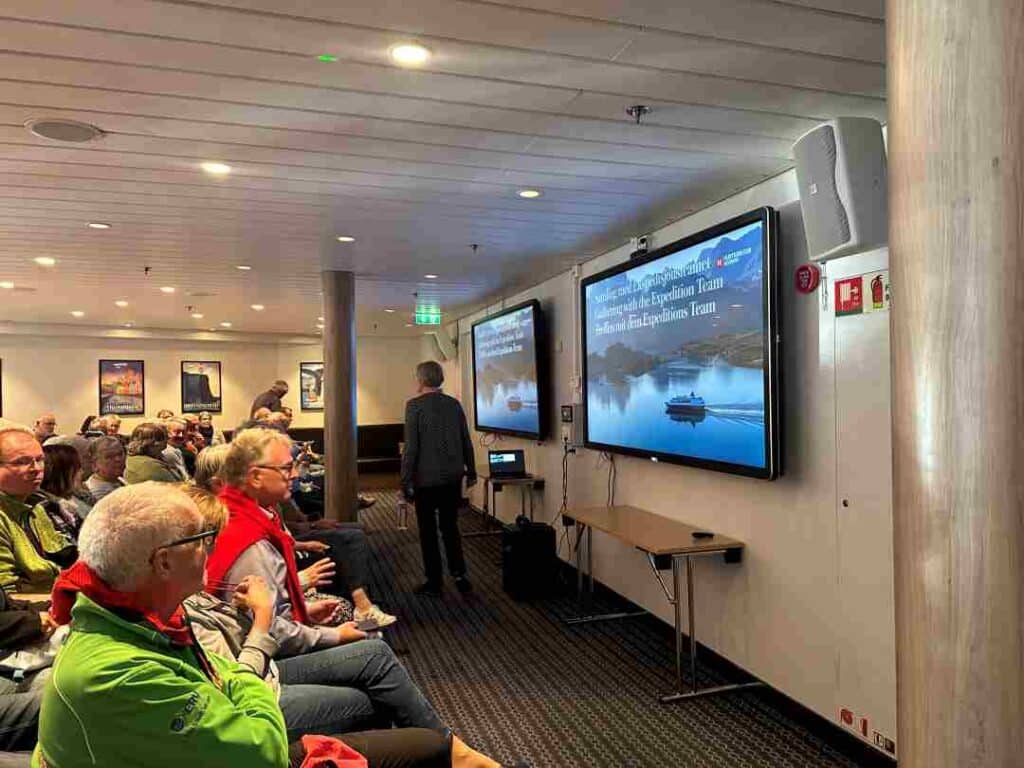
For those seeking relaxation, the panoramic lounges offer perfect spots to sit back and watch the ever-changing scenery glide by.
Some ships also feature saunas, hot tubs, and fitness rooms for passengers to enjoy. I’ve spent countless hours in these lounges, camera in hand, ready to capture the next breathtaking vista or wildlife sighting.
Photography enthusiasts will find endless opportunities onboard. The changing light, dramatic landscapes, and wildlife encounters provide a constantly shifting canvas.
My tip: don’t miss the early morning hours when the light is soft and golden, perfect for capturing the essence of the coastal landscape.
Tours and Excursions: Dive Deeper into Norway’s Coastal Wonders
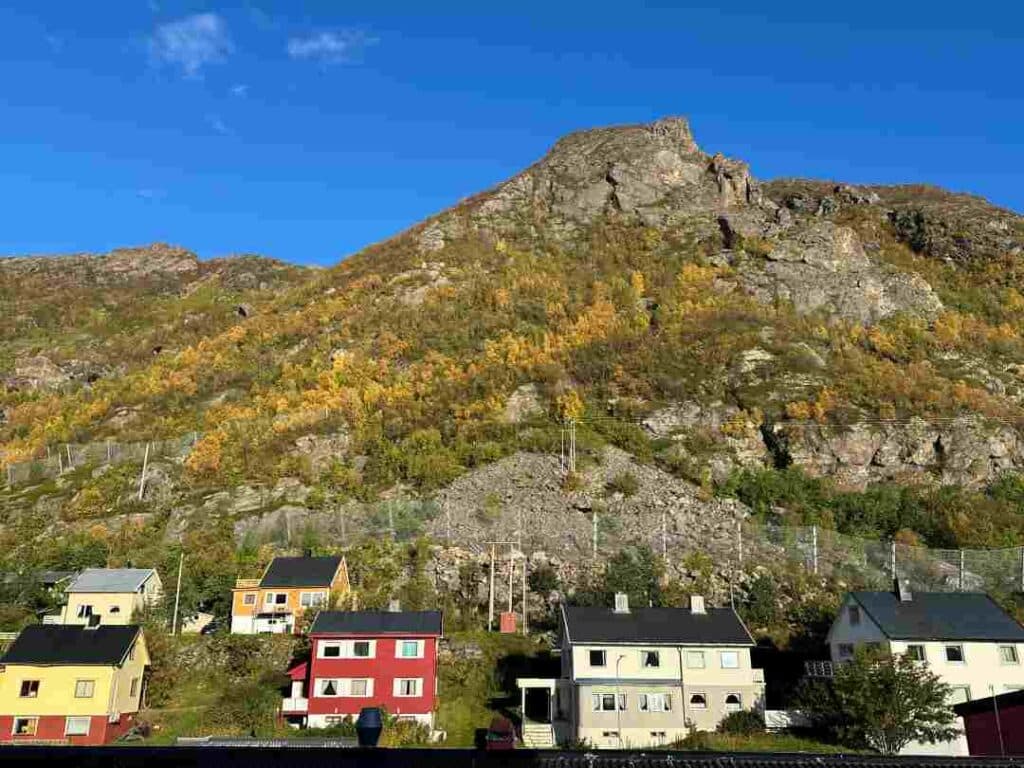
Hurtigruten offers a wide range of excursions at various ports, allowing you to dive deeper into Norway’s coastal culture and natural wonders.
These can be booked directly through Hurtigruten, ensuring a seamless experience.
📍Really popular excursions include:
- Dog sledding in Tromsø: An exhilarating ride through snowy landscapes
- Visiting the North Cape: Stand at the edge of continental Europe
- Exploring the Geirangerfjord by kayak: Paddle through one of Norway’s most famous fjords
- Whale and orca safari from Tromsø: Spot whales and orcas in their natural habitat
- Guided horse riding in Lofoten: Experience the raw beauty of these Arctic islands

For more independent travelers, it’s also possible to arrange your own activities at many ports.
Local tour companies often tailor their tour departures to the arrival and departure of Hurtigruten; you can research specific destinations online or contact the local tourist information when you arrive.
The ship typically stays in port for anywhere from 15 minutes to several hours. This means that at some ports, you will just see it from the railing, while in other places, you have hours to go ashore and explore.
One of the highlights while on the ship is also entering the narrow Trollfjorden Fjord, just meters away from the steep mountain walls.
The ship will sail slowly inside and then turn on its own axis at the bottom of the fjord before it slowly sails back out.
Just do your research in advance and make sure you keep an eye on the ship’s schedule to avoid being left behind!
From personal experience, I can say that the RIB (Rigid Inflatable Boat) safari in Lofoten, a midnight tour to the North Cape, and the midnight concert in the town church in Tromsø are unforgettable experiences you should not miss!
Best Time of Year to Travel with Hurtigruten: Every Season Offers Something Special
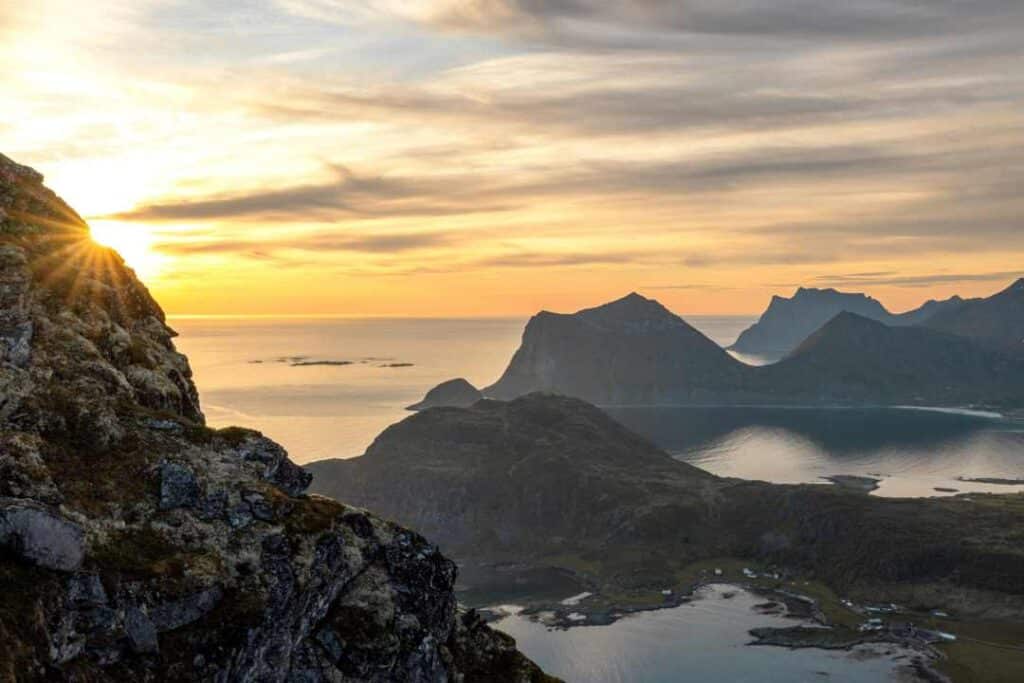
For all four seasons in Norway, you should be prepared to endure “a bit of weather.”
Although it is less likely with full-on storms in the summer, it is not unheard of. Both shoulder seasons and the winter season will be cold, windy, and sometimes wet – but definitely spectacular.
During the winter season, you just need to accept that the weather is in charge, not the captain, and not you.
Sometimes, the ship needs to skip ports due to weather conditions. And even if the ship can dock, sometimes you will be “værfast” (stuck due to weather), when roads are closed, transport impossible, and all you can do is just accept it and wait it out.
That is the “nature of nature,” especially in northern Norway, and you might as well enjoy it and think of it as an adventure provided by the elements!
Hurtigruten in Summer
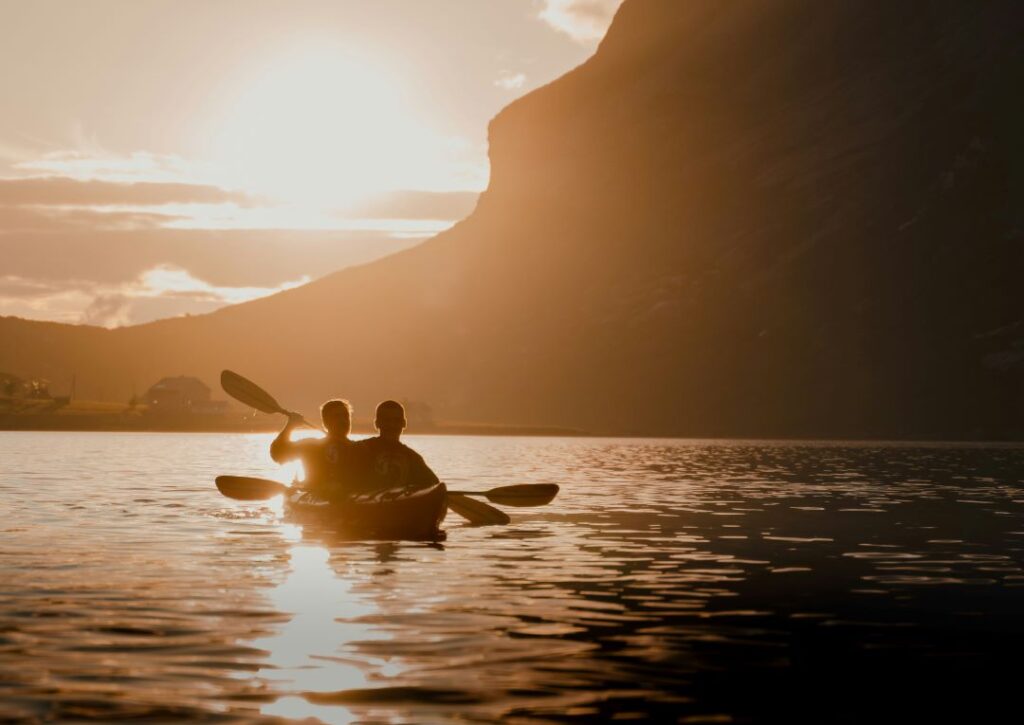
Summer (June to August) offers the magical experience of the midnight sun, where the sun never sets north of the Arctic Circle.
This is the perfect time for outdoor activities and enjoying long, bright days.
Norwegians generally don’t sleep a lot in the summer, and you will probably find it a bit difficult as well, as the sun is up and it feels like the middle of the day at midnight (bring a sleeping mask).
The weather is generally milder along the entire coastline (although it can be windy), making it ideal for hiking and exploring coastal towns.
For me, the neverending days and the midnight sun has something magic to it.
If you can, you should visit the North Cape at midnight, where you can gaze over the vast Arctic Ocean (next stop, the North Pole), where the sun is barely touching the water on the horizon before it starts rising again.
Hurtigruten in Winter
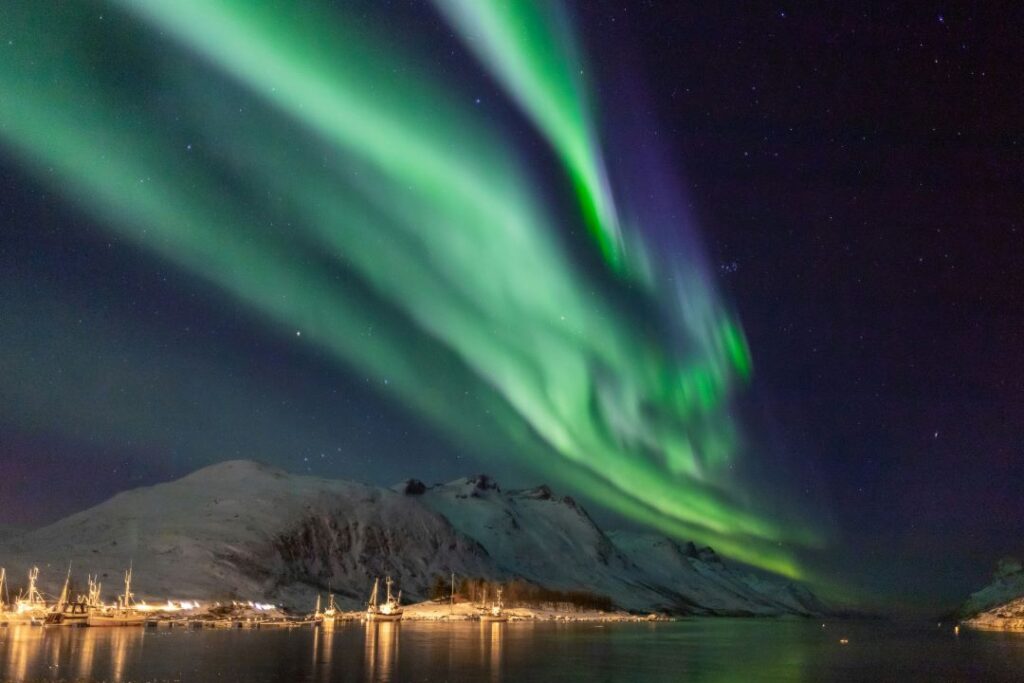
Winter (November to March) brings the opportunity to witness the mesmerizing northern lights above the Arctic Circle and sometimes also further south.
The polar night, when the sun doesn’t rise above the horizon, creates a unique and otherworldly atmosphere around your ship. During the day, you can experience the “blue light,” which is not quite daylight but not quite dark either.
Winter is also the season where you really can get to experience the fierce elements in the Arctic, and you might want to bring sea sickness pills if you are not sure how your body handles that!
Also, be aware that during winter, the weather sometimes affects the Hurtigruten itinerary. If the water, winds, or currents are not cooperating, some ports will irregularly be impossible to visit during winter.
So stormy weather can possibly cause cancellations to dock in certain ports – maybe your favorite!
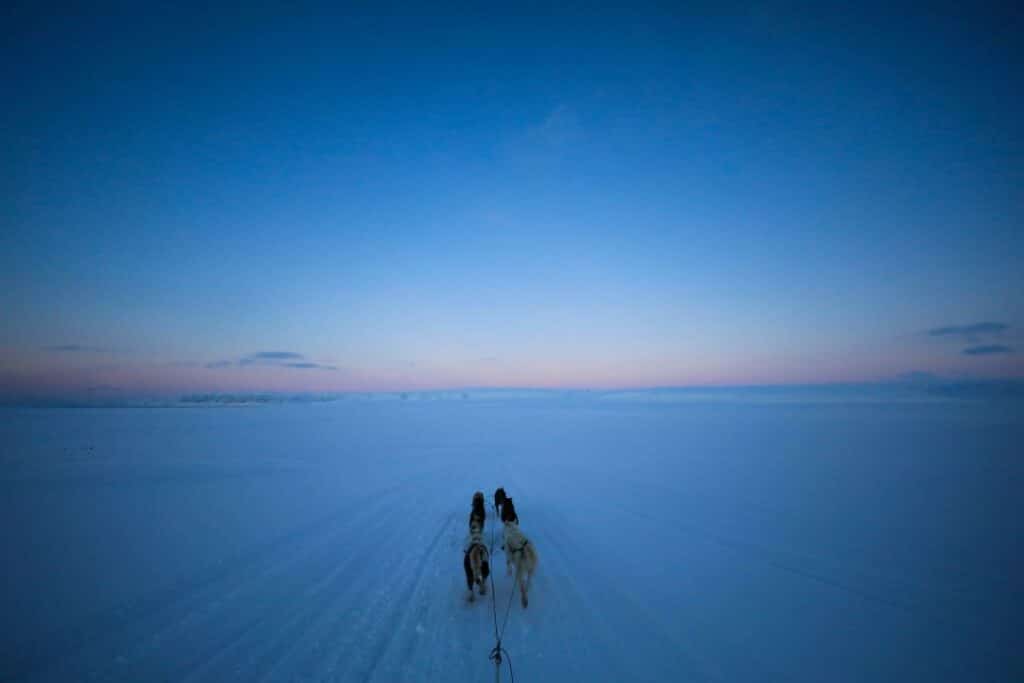
That said, the rugged mountains, steep fjords, and vast snow-covered plains in winter can make the scenery look otherworldly.
Norwegians will say “there is no bad weather, only bad clothing”, and will go about their normal day despite dramatically low temperatures. Kids play outside in -20 below zero or colder, and everyone looks like the Michelin Man!
You should keep that in mind when packing for a Hurtigruten cruise in the winter season.
Winter also offers exciting Arctic activities like dog sledding and snowmobiling. The contrast of snow-covered landscapes against dark skies provides stunning photographic opportunities.
Hurtigruten in the Shoulder Seasons
Shoulder seasons on Hurtigruten, which include spring (April to May) and autumn (September to October), offer their own charms for you as a passenger.
In spring, you will witness the coast coming to life after the long winter.
This means that rivers and waterfalls will be impressive, as snow is melting higher up in the mountains, and birds and wildlife that have been away for winter are starting to return.
Autumn brings beautiful fall colors and the first chance to see the northern lights.
Personally, September is my favorite month in Norway, as nature explodes with a kaleidoscope of colors in the forests, mountains, and plans. The temperatures are still comfortable (at least until the start of October), and the air is crisp and has a warm light.
The changing seasons provide a dynamic backdrop for photography and exploration. Shoulder seasons also tend to be less crowded and can offer better prices.
Hurtigruten’s Coastal Fleet: A Guide to Norway’s Iconic Ships
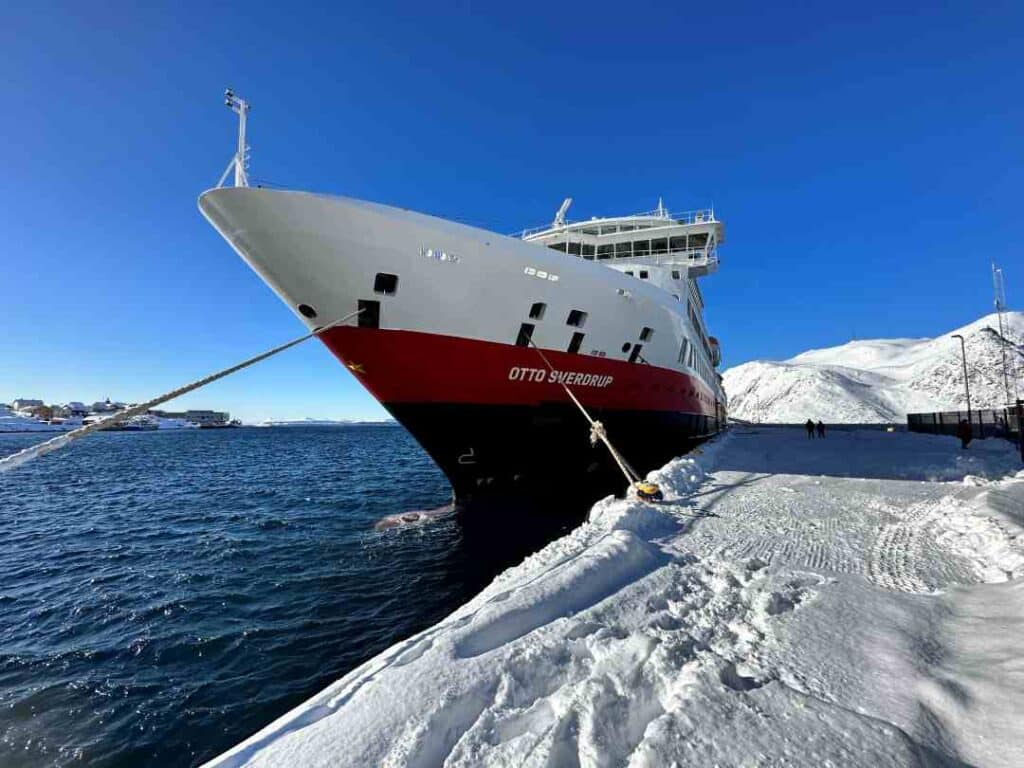
Hurtigruten operates a fleet of 9 ships along the Norwegian coast, each with its own unique character and features. Here’s a brief overview of each vessel:
MS Vesterålen
Named after the archipelago where Hurtigruten founder Richard With was born, MS Vesterålen is one of the smallest and oldest ships in the fleet.
Built in 1983, it offers a more intimate and traditional coastal experience.
Despite its age, it has been refurbished to provide comfortable accommodations while maintaining its classic charm. Its small size allows it to navigate some of the narrower fjords with ease.
MS Nordlys
The ship features a two-story panorama lounge, providing excellent views of the passing coastal scenery.
It’s a mid-sized ship in the fleet, offering a good balance between amenities and a cozy atmosphere.
MS Nordlys, meaning “Northern Lights,” was built in 1994 and refurbished in 2019. Its interiors are inspired by the aurora borealis, with a color palette reflecting the northern lights.
MS Kong Harald
Named after the current King of Norway, MS Kong Harald entered service in 1993 and was extensively upgraded in 2016.
The ship’s interiors are decorated with beautiful Norwegian art, creating a sophisticated ambiance.
It features spacious public areas, including a two-story panorama lounge, and offers a range of cabin categories to suit different preferences and budgets.
MS Polarlys
MS Polarlys, meaning “Polar Light,” joined the fleet in 1996 and was refurbished in 2016. The ship’s interiors are inspired by the Arctic light, with a modern Scandinavian design.
It offers comfortable public spaces, including a panorama lounge and a fitness room.
Despite being one of the older ships in the fleet, its recent refurbishment ensures a pleasant and modern travel experience.
MS Nordnorge
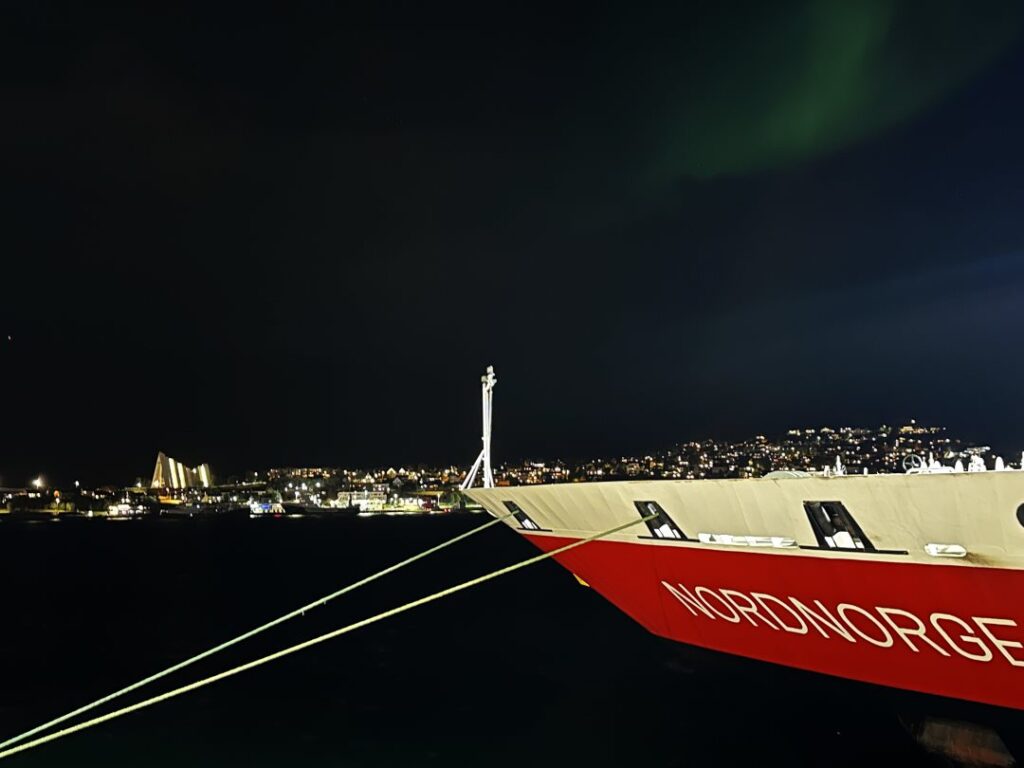
Built in 1997 and refurbished in 2016, MS Nordnorge is named after the northern part of Norway.
The ship features art by the famous Norwegian artist Karl Erik Harr, reflecting the beauty of the coastal landscape.
It offers spacious cabins and suites, many with sea views. The ship’s outdoor explorer deck is perfect for viewing the spectacular scenery and potential wildlife sightings.
MS Richard With
Named after Hurtigruten’s founder, MS Richard With was built in 1993 and underwent a complete renovation in 2018.
The ship now features a modern Scandinavian design with natural materials like granite, oak, and birch.
It offers a range of cabin types, including some of the fleet’s most luxurious suites. The ship also boasts three different restaurants, offering a variety of dining experiences.
MS Trollfjord
MS Trollfjord, named after the famous narrow fjord in Vesterålen, entered service in 2002.
It’s one of the largest ships in the coastal fleet, offering spacious public areas and a wide range of facilities.
The ship features a two-story panorama lounge with floor-to-ceiling windows, providing spectacular views. Its modern design and amenities make it a popular choice among passengers.
MS Midnatsol
MS Midnatsol, meaning “Midnight Sun,” was built in 2003 and is one of the largest ships in the coastal fleet.
It features a distinctive sun deck and a large, two-story panorama lounge, offering excellent views of the Norwegian coastline.
The ship is also equipped with a pool and two hot tubs. Its size and facilities make it well-suited for the coastal voyage, especially during the summer months.
MS Spitsbergen
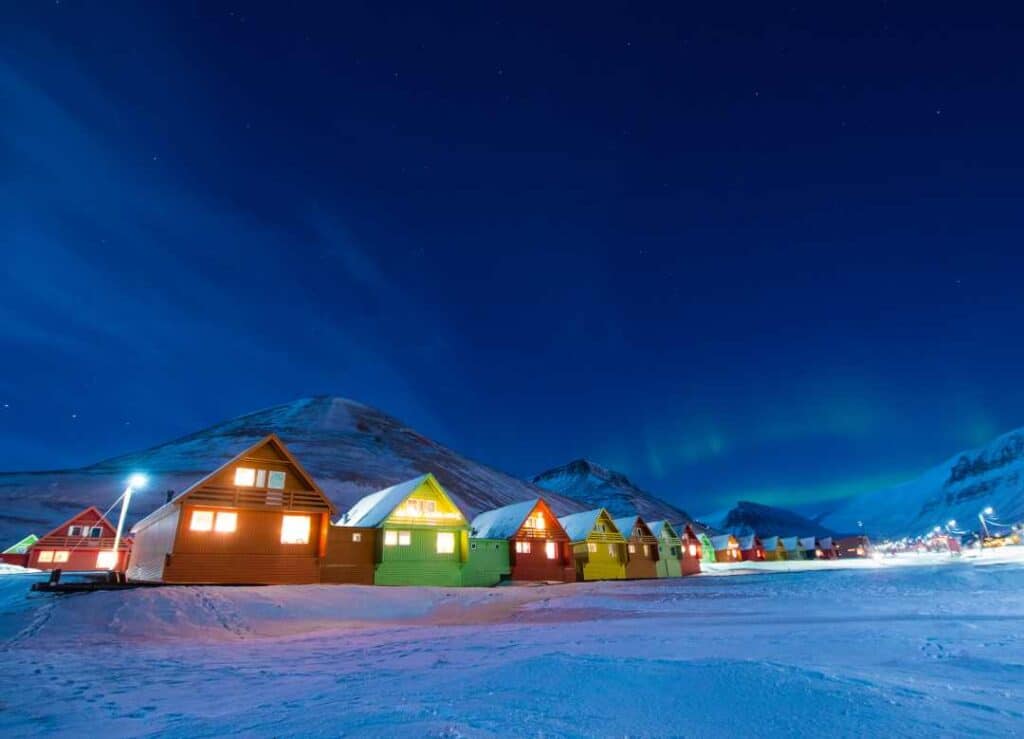
The newest addition to the coastal fleet, MS Spitsbergen, joined in 2016. Named after the largest island in the Svalbard archipelago, this ship was specially designed for Arctic waters.
It’s smaller and more maneuverable than some of the other ships, allowing it to access ports that larger vessels can’t. The ship features a modern Scandinavian design and state-of-the-art environmentally friendly technology.
Each of these ships offers a unique way to experience the Norwegian coast, from the intimate atmosphere of MS Vesterålen to the modern luxury of MS Spitsbergen.
The variety in the fleet ensures that there’s a Hurtigruten ship to suit every traveler’s preference.
Complete List of Hurtigruten 34 Ports: A Coastal Norway Guide
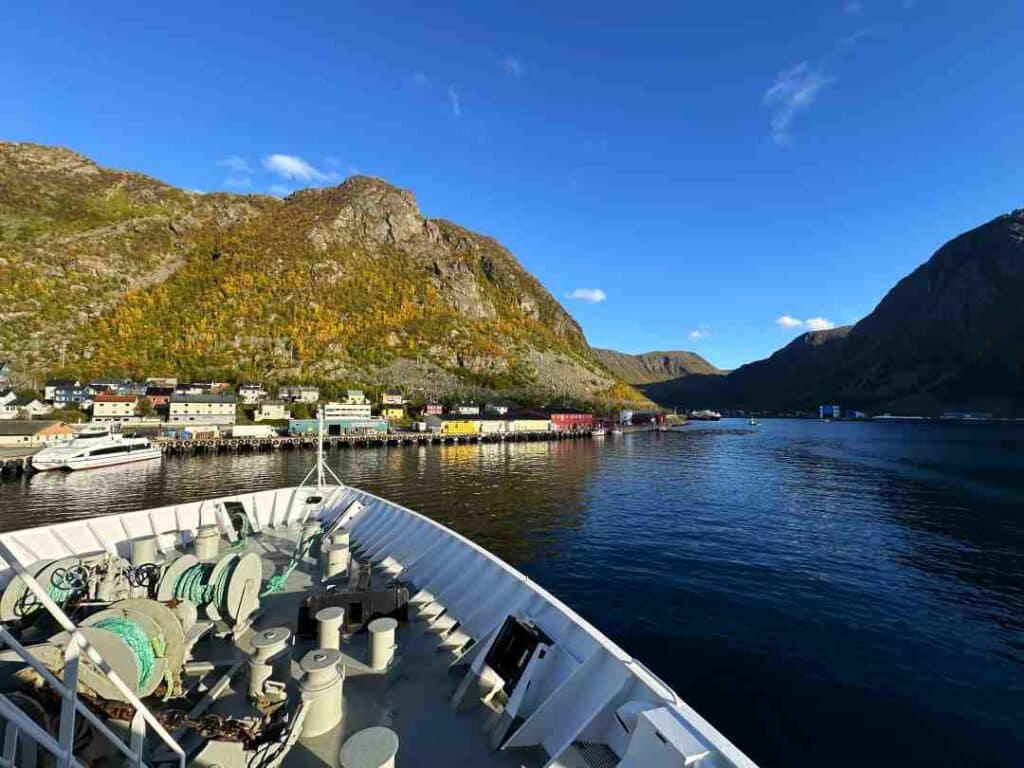
- Bergen: Known as the “Gateway to the Fjords,” this UNESCO World Heritage city is famous for its colorful Hanseatic wharf, Bryggen, and the fish market.
- Florø: Norway’s westernmost town, known for its fishing industry and proximity to the Kinn islands.
- Måløy: A small town on the island of Vågsøy, famous for its lighthouse and WW2 history.
- Torvik: A tiny port on the island of Leinøya, offering access to the beautiful Herøy municipality.
- Ålesund: Rebuilt in Art Nouveau style after a 1904 fire, it is known for its unique architecture and the panoramic view from Mount Aksla.
- Geiranger (summer only): Home to the spectacular UNESCO-listed Geirangerfjord, one of Norway’s most famous fjords.
- Molde: Known as the “City of Roses,” offering panoramic views of 222 mountain peaks.
- Kristiansund: Built across four islands, known for its klippfisk (dried cod) history and the Atlantic Road nearby.
- Trondheim: Norway’s third-largest city and former capital, home to the impressive Nidaros Cathedral and charming wooden architecture.
- Rørvik: A small fishing town in the Vikna archipelago known for its coastal culture.
- Brønnøysund: Home to the famous Torghatten mountain with its distinctive hole through the center.
- Sandnessjøen: Gateway to the Helgeland coast, near the Seven Sisters mountain range.
- Nesna: A small agricultural and fishing community on the Helgeland coast.
- Ørnes: A small town offering views of the Svartisen glacier, Norway’s second-largest.
- Bodø: Just north of the Arctic Circle, known for the world’s strongest tidal current, Saltstraumen.
- Stamsund: A fishing village in the Lofoten Islands known for its art scene.
- Svolvær: The largest town in the Lofoten Islands, surrounded by dramatic mountain peaks.
- Stokmarknes: Birthplace of Hurtigruten, home to the Hurtigrutemuseet (Coastal Express Museum).
- Sortland: Known as the “Blue City” due to an art project that saw many buildings painted blue.
- Risøyhamn: A small village on Andøya, known for its proximity to whale-watching areas.
- Harstad: The third-largest city in Northern Norway, known for its cultural scene.
- Finnsnes: Gateway to Senja, Norway’s second-largest island, known for its diverse landscapes.
- Tromsø: “Paris of the North,” a vibrant Arctic city known for its midnight sun, northern lights, and rich culture.
- Skjervøy: An island community known for its fishing industry and salmon farming.
- Øksfjord: A small town offering views of the nearby Øksfjordjøkelen glacier.
- Hammerfest: One of the world’s northernmost towns, home to the UNESCO-listed Struve Geodetic Arc.
- Havøysund: A small fishing village offering insight into coastal Finnmark life.
- Honningsvåg: Gateway to the North Cape, Europe’s northernmost point.
- Kjøllefjord: A small fishing village known for its distinctive church and proximity to Finnkirka sea cliff.
- Mehamn: Norway’s northernmost mainland port, known for its king crab fishing.
- Berlevåg: A remote fishing village, the subject of a famous documentary about its male choir.
- Båtsfjord: Known for its fishing industry and bird cliffs.
- Vardø: Norway’s easternmost town, home to the Steilneset Memorial and the Vardøhus Fortress.
- Kirkenes: The turnaround point of the Hurtigruten voyage, close to the Russian border, known for its Snow Hotel in winter.
This list covers all ports from south to north, and the timings for Hurtigruten’s arrival and departure are different on the northbound and southbound routes.
Remember that some ports are seasonal (like Geiranger), and the ship may stop at different ports on the northbound and southbound journeys.
FAQs about Hurtigruten
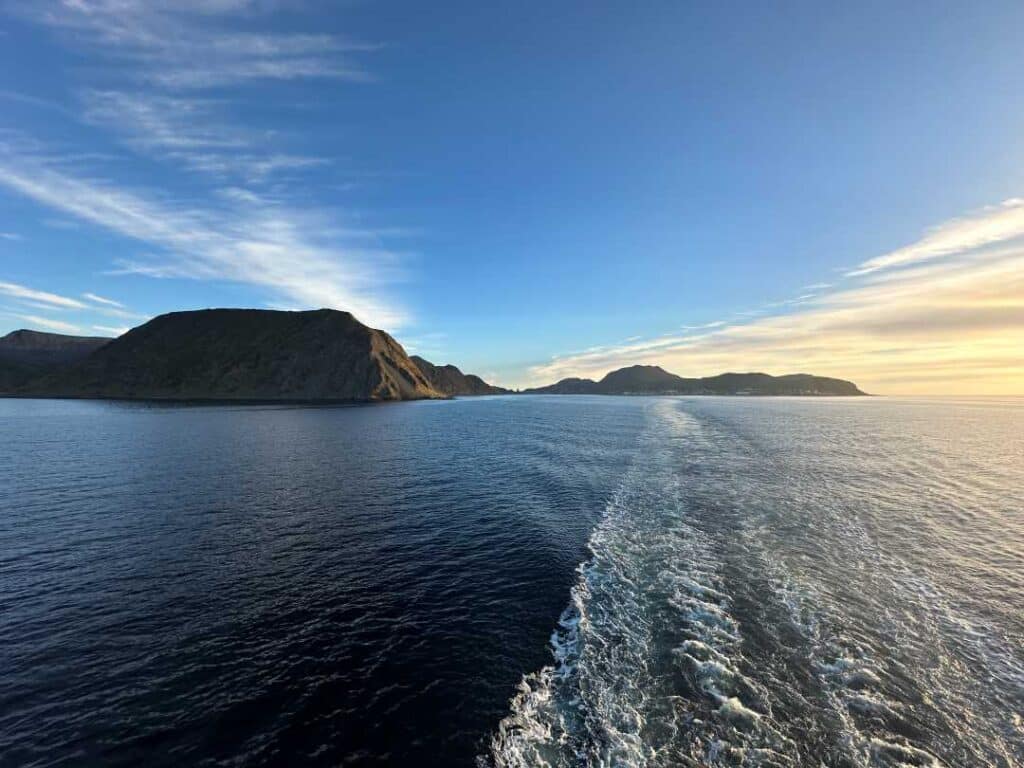
How long is the full Hurtigruten voyage?
The complete round trip from Bergen to Kirkenes and back takes 13 days.
However, it’s possible to do shorter segments of the journey, known as port-to-port trips. These can range from a few hours to several days, allowing you to customize your coastal experience.
What should I pack for a Hurtigruten trip?
Pack layers for varying weather conditions, comfortable walking shoes, and a good camera. In winter, warm clothing is essential – think thermal underwear, a heavy-duty waterproof jacket, warm boots, a hat, and gloves.
Don’t forget swimwear if you want to use onboard hot tubs or take a dip in the Arctic waters!
For photography enthusiasts, I recommend bringing a tripod for northern lights photography and a zoom lens for wildlife spotting.
Can I see the northern lights on Hurtigruten?
Yes, during the winter months (roughly September to March), it’s possible to see the northern lights from the ship. However, sightings are never guaranteed as they depend on solar activity and weather conditions.
Hurtigruten offers a Northern Lights Promise on select voyages – if the lights don’t appear, you get another cruise for free!
Is Wi-Fi available on Hurtigruten ships?
Yes, Wi-Fi is available on all Hurtigruten ships, although the connection can be intermittent due to the remote nature of the voyage. I recommend embracing the opportunity to disconnect and immerse yourself in the coastal experience.
Can I Bring A Car To Hurtigruten?
Yes, you can bring a normal passenger car on Hurtigruten. However, big vans and camper vans can not be brought on board.
Wrap-Up: A Journey That Will Stay With You Forever
A Norwegian coastal voyage with Hurtigruten is more than just a cruise (and very unlike a traditional Caribbean or Mediterranian cruise) – it’s a journey through the heart and soul of coastal Norway.
From the stunning natural beauty of the fjords to the rich cultural heritage of coastal communities, you get to see the raw, rugged beauty of the Arctic.
Whether you’re chasing the northern lights in winter or basking in the midnight sun in summer, Hurtigruten offers a unique and authentic way to experience the best of Norway’s coastline.
It’s a reminder of the raw power of nature, the richness of cultural traditions, and the warmth of communities that have thrived in this challenging yet beautiful coastal environment for centuries.
The only downside is that you probably will wish you had more time to explore the amazing destinations in all the ports that you visit!
Related blog posts:
Ultimate Guide: When To See The Northern Lights In Norway?

